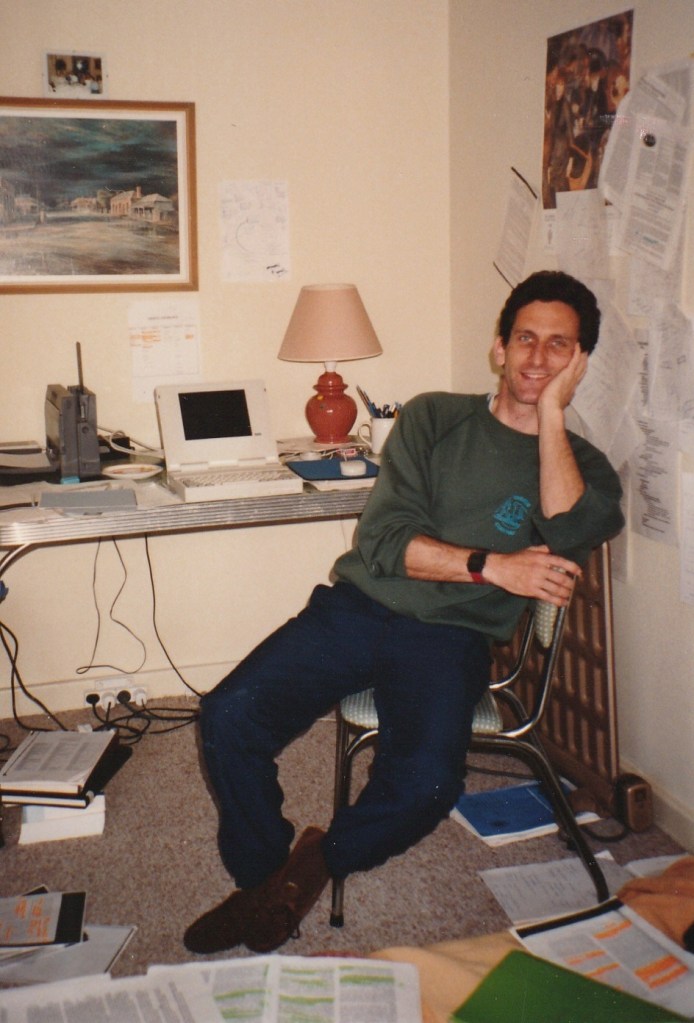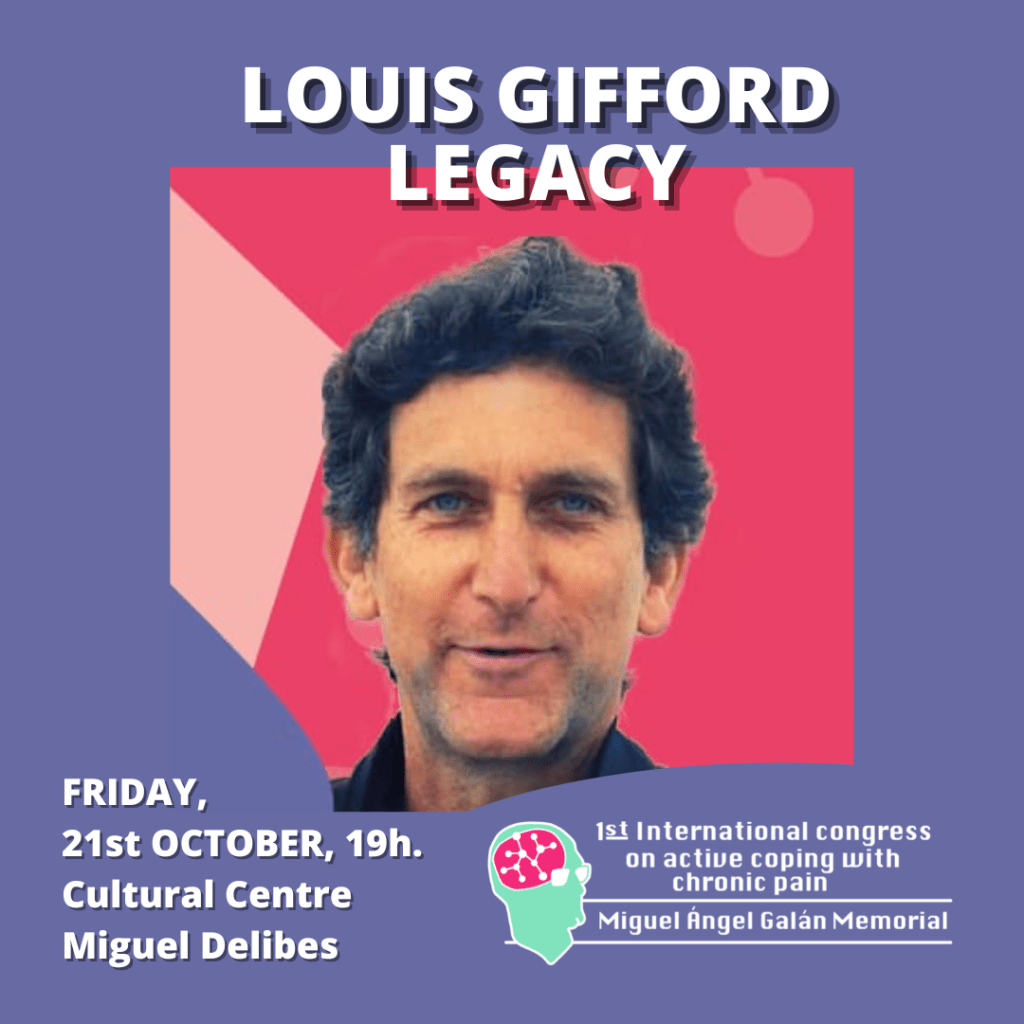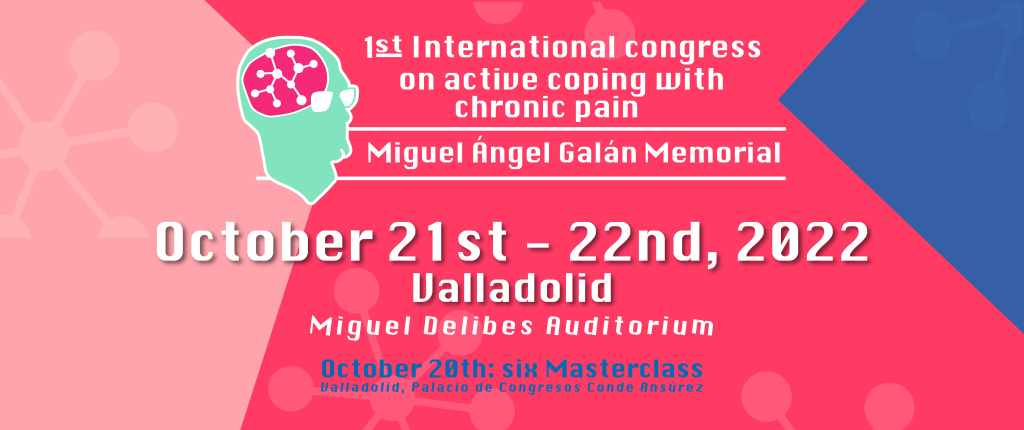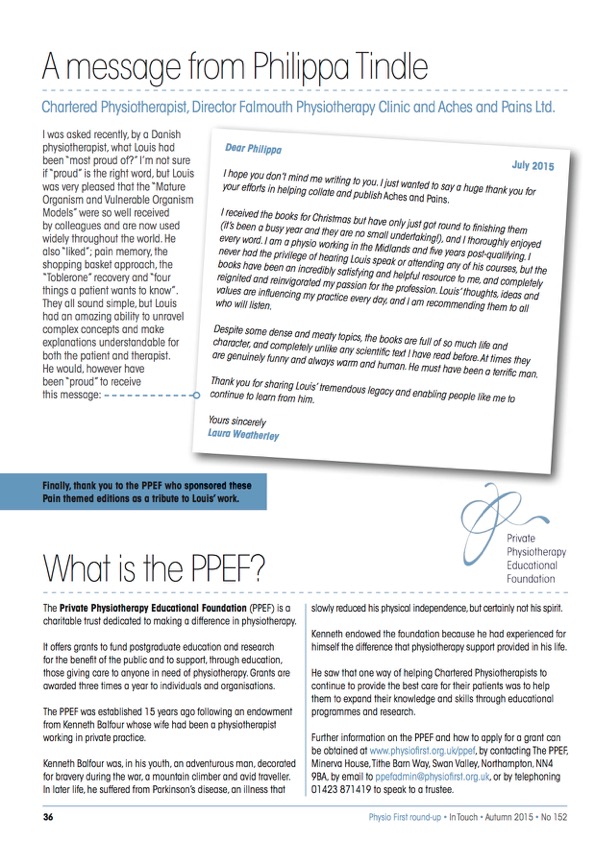Last weekend I was lucky enough to spend time with some very special human beings who are also physiotherapists. I’d like to use Louis’ blog to thank them, alongside my tribute to Louis.
Thank you to Fede Montero for having the vision to make all this happen.
Thank you to Clara Berge and Maria Galve for their kind introduction and Jorge Rodriguez for the video. Thanks to Ines Vicente for her brief talk about Louis’ mature organism model (MOM). And thanks to Gustavo Paseiro the President of Council for his words too.
Thank you all for coming.
Hola, I’m Philippa Tindle, a physiotherapist. I’m here today to represent another physiotherapist, Louis Gifford, who was my partner, husband and friend. I’m really sorry that Louis can’t be here. I think you would have liked him.
Sadly, Louis died in February 2014 of prostate cancer. He was too young. Sometimes it feels like 8 years ago, sometimes like 8 months, sometimes 8 days. Sometimes, like it never happened and he’s going to walk in through the door. I miss sharing my day with him and being held.
I have no words to express my thanks for the generosity of the Congress Organizing Committee for including this tribute to Louis today. You have very big hearts.
But it was the words of Maria Carmen about her husband Miguel that really persuaded me to come. She described him as, ‘… a visionary, a non-conformist, who devoted his time to seek solutions to improve the health of patients. His flaws cast little shadow‘. What wonderful words – and they remind me so much of Louis. I’m sorry that I never met Miguel. I know I would have liked him.
And I think you should all be very proud for making this congress happen at this very difficult anniversary. The first anniversary of Miguel’s death. The world needs good people like you for the future.
Before I talk a little about Louis’ legacy, I would like to mention our good friend Mick Thacker. I’m also sorry that he is not here today. I have just re-read his foreword in book one of Louis’ Aches and Pains. Mick’s words capture the essence of Louis, the human being. I urge you to read them too. Mick covers all that I need to say.
Mick regularly acknowledges that Louis’ MOM model (1st published nearly 25 years ago) remains one of the most influential and best models of pain within and outside physiotherapy. He rates its impact with that of Melzack and Wall’s Pain Gate Theory – what an accolade.
Louis, in turn, described Mick as ‘the most pain informed physiotherapist on the planet’. I would recommend that you all listen to Mick’s podcasts and read his literature and references. Mick’s research and understanding of predictive processing and that pain is a perception not a sensation is really exciting for the present and future of our profession. I believe Mick very adequately describes, on many platforms, how good science has helped physiotherapists journey from the periphery, up to the brain and now we are hopefully understanding that they are not mutually exclusive. And it’s not a linear connection – hurrah!
So, what can I say about Louis that might be of interest to you all? I rather unfairly asked Maria Galve the same question. She made a few very useful suggestions; ‘What drove Louis?’ ‘How did he come to the MOM model?’ ‘How did he shift his thinking and what triggered it?’ ‘How did he deal with critics?’ And ‘Any take home messages?’ Unfortunately, I don’t think there are any simple answers to these questions. If you’ll bear with me, I’d like to put our career journey into a historical context – now that I’ve just retired it feels like history! Louis and I qualified as Physiotherapists in 1981 (we both had first degrees in Zoology). Our physiotherapy training was based around using our hands, exercise and electrotherapy to treat patients. Treatment was all tissue based in the periphery – unless you’d had a head injury! We did do some neurology rehabilitation. After we qualified, we sought out work with experienced and well-respected physiotherapists who were involved in teaching and publishing. And I would advise anybody who can be flexible and move to work alongside a good team – do it! It’s very rewarding. Louis always had a desire to listen, watch and learn throughout his whole career (but I’ll say more about this later).
We headed to Adelaide in the mid 1980s to study the year long manipulative therapy course and work with Geoff Maitland. Geoff’s clinic was well known throughout Australia, consequently it attracted the ‘hard to help’ patients, who had been seen by many other therapists. Most had complex pain problems – but we didn’t know this at the time! Louis once came home from work and said something like ‘I’ve only helped 2% of my patients for 1% of time’. He even contemplated a break from physiotherapy and working on a building site – thankfully he didn’t! But he was definitely frustrated and dissatisfied with what we’d been taught at college and what we’d experienced in the early years of our careers. It wasn’t making sense of the ‘patient in front of us’.
Louis was incredibly curious and inquisitive about many things in life. He read extensively around subjects that interested him – writing and making notes in all the margins of everything he read (and I have full bookshelves to prove it). He loved to ‘learn something new each day’. And it became a daily joke when he asked our sons, ‘What have you learnt today?’ and they replied, ‘They couldn’t remember!’
But as a clinician Louis was always motivated to answer clinically based questions. He wanted more rational and better explanations, particularly for ongoing pain states, both to prevent his own ‘burn out’ and to help patients more.
In 1988 we returned to the UK to take over Louis’ parents physiotherapy clinic in Falmouth, Cornwall. Louis was now reading extensively into other disciplines literature, and he describes his early ‘ha ha’ moments in section 4 of book one of Aches and Pains. Pat Wall’s work helped sort of lift the ‘pain fog’ for him.

Louis returned to Adelaide in late 1993 to complete a short master’s programme. And he wrote his 2-day course The Clinical Biology of Aches and Pains Parts 1 & 2. He really was way ahead of his time.
Back in the UK in early 1994 Louis continued to expand his knowledge and understanding of pain. He spent time at the INPUT pain management programme at St Thomas’ Hospital in London. And I think the UK Physiotherapy ‘Pain Revolution’ sort of started? Although revolution is maybe the wrong word – as it means ‘complete upheaval’. But changing beliefs and behaviours is slow (and there are many people reluctant to change at all). Around this time Louis was teaching the ‘Dynamic nervous system’ course with David Butler. We’d set up the Neuro Orthopaedic (NOI) group UK and various courses were taught under this banner. The standout moment on these long courses was when Louis interviewed a number of often complex pain patients in front of the course students. The patients knew that it was part of a teaching programme. Louis’ communication skills, listening, making the patient feel comfortable and heard was amazing to observe (to his credit David even took notes!). Often the course students (who were all postgraduate physios) would say that it was after observing these patient encounters that they started to understand the pain biology and concepts that Louis had been explaining in his lectures. His ideas began to make sense – they had their ‘ha ha’ moment! Louis was also highly skilled at the physical examination of patients – learnt over 10 + years of manual therapy. He had lovely hands and handling skills. But he made examination totally relevant, and he fully explained his findings to the patient. Remember this is nearly 30 years ago! At that time we even had to put pain terminology glossaries in the student’s workbooks. Nobody knew what allodynia was! The combination of excellent interviewing and physical examination skills led to Louis confidently explain ‘pink or positive flags’ and that it was ‘safe to load’ – allaying fear of movement and pain to patients.
As far as I’m aware none of these patient interviews were recorded. Because of his poor prognosis after his prostate cancer diagnosis (it had already metastasised) Louis decided to stop teaching in 2007. Without the PCa diagnosis I think he would have loved to be recorded interviewing patients and being interviewed himself.
Between 1998 and 2006 Louis edited and wrote chapters in the Topical Issues in Pain books 1- 5. We self-published these books. They represent the work from the UK Physiotherapy Pain Association study days and are still relevant today.
Surprisingly Louis was always very anxious before teaching and seeing patients in our clinic. You wouldn’t have known it. Once ‘on the stage’ or ‘with the patient’ he seemed very relaxed. I am biased but I could listen to him lecture all day and then the next! He was easy to listen to, funny, he made complicated theories understandable and swore quite a lot! For him to lecture with this ease he knew and understood everything he was teaching (and more). As for his patients in the clinic – he read all their notes at the start of each day so that he could confidently greet them.
But Louis wasn’t perfect. He didn’t ‘fix’ all his patients. But he made sure that all had a better understanding of their problem. He allayed their fears and answered their questions. His foreword in Susan Greenhalgh and James Selfe Red flags handbook explains this better.
In this very short talk I hope, in some way, that I have been able to give you some insight into Louis’ journey. He was driven by wanting better answers for both himself and patients. The MOM was a culmination of maybe 20 years of reading and thinking and questioning existing beliefs. He would have been so pleased and amazed that it is being used so widely as a teaching tool today. If he had lived longer, I think he would have developed other useful models, and refined the MOM. The MOM is of a time, and he would be pleased that others are continuing ask questions in the light of new knowledge and research. Louis ‘shopping basket approach’ and ‘toblerone recovery’ concepts are also worth reading.
I was asked ‘How did Louis deal with critics?’ I’ll give you a couple of examples. I can’t remember the exact date – maybe early ’90s – Louis was presenting a short lecture on the sympathetic nervous system in London to a group of physiotherapists. At one point a ‘bolshy’ physio stood up and disagreed quite passionately with what Louis was saying. Louis listened and agreed that there could be another way of interpreting whatever he was discussing. The ‘bolshy’ physio was Mick Thacker! Later, I contacted Mick and asked if he would like to come on one of Louis’ Clinical Biology of Aches and Pains courses, where there was time for more depth of information and discussion. Mick kindly accepted and the rest is history. From this encounter Louis and Mick developed one of the most extraordinary, respectful and productive partnerships. Thank you, Mick.
In contrast, Louis once wrote an editorial in the Physiotherapy Pain Association (PPA) journal criticising the McKenzie principles of repeated lumbar extension and avoidance of flexion. He discussed how, in his clinical experience, he’d seen many patients who’d developed sciatica after being told to perform lumbar extension regularly. And he also discussed how many therapists fear lumbar flexion and pass that fear to their patients! Well, the ‘shit hit the fan’. Louis was totally vilified by the McKenzie Institute. In his defence he published all their replies in the next PPA journal. The institute were more selective in what they published in theirs! They have never forgiven him!
When Louis taught his courses, he would always say to his students at the beginning of the first morning, ‘Interrupt me anytime to ask questions – but please do it nicely!’ I think he quite cleverly deflected any student with any ‘axe to grind’ or who liked the sound of their own voice! And Louis never had any issues when teaching and he certainly enjoyed a good debate.
And in the context of this tribute a few thoughts to maybe take home?
Our profession is hard but also very rewarding.
Pain is complex for everybody
Keep reading and learning.
Improve your communication skills with your patients.
Allay patients fear of movement.
Challenge your teachers – but do it nicely!
Challenge your own beliefs and behaviours.
If you think you know it all – you don’t!
If you think you do it well – do it better!
Be selective with your online learning. I’m biased but I’d start with Mick.
Don’t’ be seduced by the ‘pain salesman’ out there. Don’t try and squeeze their models into your own just because that’s the easier option.
Be your own therapist.
Love the patient in front of you as a person and human being; listen and hear them, try and understand what they feel and think?
Laugh, sing and dance with your patients – and occasionally cry!
And please have fun!
Finally, I’d like to read out some of Mick’s words, ‘ … that patients all over the world are treated more wisely and with more respect because of the ideas and insights Louis offers. Ideas he gives freely and generously without a hint of self-importance and ego’.
And, without apology, I’d like to borrow Maria Carmen’s words and say, ‘ thank you for remembering him’.
Thank you for listening to me.
Philippa Tindle, October 21st 2022, Valladolid, Spain.

One of Louis’ favourite places doing one of his favourite things – flyfishing!
Thank you to our niece Megan Henwood who closed the tribute to Louis with the song she wrote for him ‘Painkiller’
HEAD HEART HAND









